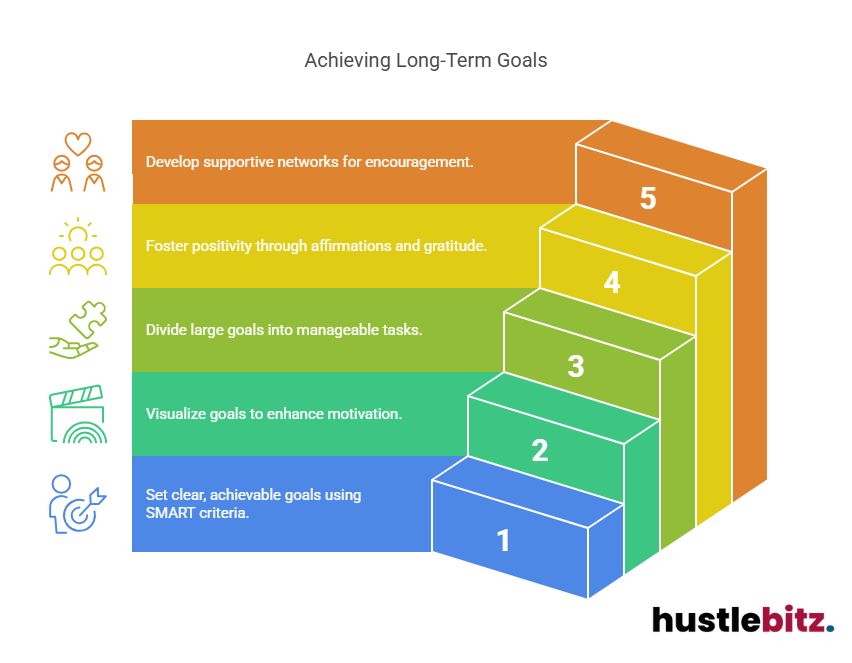Staying motivated to achieve long-term goals involves several key strategies. First, clearly define your goals using SMART criteria. Create a vision board to visually represent your aspirations. Establish a consistent routine that integrates productive daily habits. Break larger objectives into manageable steps, celebrating each milestone to fuel motivation. Stay flexible and adapt your plans as necessary while maintaining a positive mindset through affirmations and gratitude practices. Building supportive relationships with accountability partners also enhances commitment. Implementing these strategies can significantly bolster your drive towards achieving your goals, and there is more valuable information on how to enhance this journey effectively.
Key Takeaways
- Define clear long-term goals using the SMART criteria to create a structured roadmap for success.
- Create a vision board to visually represent your goals and enhance motivation through personal aesthetics.
- Break larger goals into manageable steps, prioritizing tasks and celebrating milestones to maintain momentum.
- Maintain a positive mindset through practices like affirmations and gratitude to foster resilience and optimism.
- Build supportive relationships with encouraging individuals and accountability partners to enhance commitment and motivation.

Define Your Long-Term Goals
Defining your long-term goals is essential for creating a clear roadmap that guides your actions and decisions towards achieving meaningful success.
Establishing goal clarity allows you to align your aspirations with your personal values, ensuring that your efforts resonate with what you truly desire in life. When setting these goals, employing the SMART criteria—Specific, Measurable, Achievable, Relevant, and Time-bound—can significantly enhance their effectiveness.
To cultivate a comprehensive understanding of your future aspirations, consider engaging in timeline planning. This technique not only establishes a realistic framework for your goals but also aids in identifying potential obstacles and necessary resources.
Recognizing your motivation sources, such as intrinsic motivation, can further strengthen your commitment to achieving these objectives.
In addition, enlisting accountability partners can provide valuable support and encouragement as you navigate your path. These individuals can help you stay on track, offering feedback and insight into your progress.
Incorporating goal tracking mechanisms, whether through journaling or digital tools, enables you to monitor your advancements and make adjustments as needed.
Create a Vision Board

A vision board serves as a powerful visual representation of your long-term goals, helping to clarify your aspirations and keep you motivated throughout your journey. By incorporating various vision board ideas, you can create a customized display that reflects your ambitions.
Utilize creative materials such as magazines, photographs, or drawings to compile visual inspiration that resonates with you. Thematic organization is essential; categorize your goals into sections such as career, health, relationships, and personal growth. This approach ensures a clear focus and aids in goal visualization.
Here’s a simple layout to consider when designing your vision board:
| Category | Visual Elements | Motivational Quotes |
| Career Goals | Images of your dream job | “Success is the sum of small efforts.” |
| Health Goals | Fitness icons or activities | “Your body can stand almost anything.” |
| Personal Growth | Books or skills to learn | “The only limit is your mind.” |
| Relationships | Photos of loved ones | “Surround yourself with love.” |
You can choose to create a traditional board or explore digital options, such as apps or platforms that allow for collaborative boards. Consider seasonal updates to keep your vision board fresh and relevant. Incorporating personal aesthetics ensures that your board remains visually appealing, enhancing your motivation to pursue your goals.
Establish a Routine

Establishing a routine is crucial for maintaining focus and consistency as you work toward your long-term goals. A well-structured routine helps you develop daily habits that foster productivity and enhance your time management skills. By allocating specific times for tasks, you can create a framework that minimizes distractions and maximizes efficiency.
Incorporating morning rituals can set a positive tone for your day, allowing you to start on the right foot. These rituals might include practices such as meditation, exercise, or reviewing your goals, which can enhance your mental clarity and overall motivation.
Similarly, evening reflections provide an opportunity to evaluate your progress, celebrate small victories, and identify areas for improvement, reinforcing your commitment to your objectives.
Engaging with accountability partners can further strengthen your routine. By sharing your goals with someone who supports your journey, you create an additional layer of motivation and encouragement. They can help you stay on track while providing constructive feedback on your progress.
Utilizing productivity tools, such as digital planners or apps for goal tracking, can simplify the process of monitoring your achievements.
Healthy routines that include stress management techniques, such as yoga or mindfulness practices, can also contribute to your well-being, ensuring that you remain focused and energized.
Break Goals Into Manageable Steps

Breaking long-term goals into manageable steps is essential for maintaining motivation and tracking progress effectively. By dissecting larger objectives, individuals can achieve incremental progress and create a clearer path toward success. This approach allows for the prioritization of tasks, making it easier to set deadlines and keep momentum.
To effectively manage your goals, consider the following framework:
| Step | Action Item | Reward |
| 1 | Identify main goal | Visualize success |
| 2 | Break goal into tasks | Celebrate milestones |
| 3 | Set deadlines | Reward yourself |
| 4 | Track achievements | Seek accountability |
| 5 | Adjust timelines | Limit distractions |
In this table, the first column outlines the steps to take, the second column specifies the action items for each step, and the third column highlights the rewards that come from completing these actions. As you move through each stage, make sure to celebrate milestones to maintain motivation and acknowledge your hard work.
Additionally, visualizing success can reinforce your commitment, while seeking accountability from peers or mentors can provide external motivation. Remember to limit distractions and adjust timelines as necessary to stay on track. By breaking your long-term goals into manageable steps and rewarding yourself along the way, you can maintain a high level of motivation and ensure continued progress toward your aspirations.
Stay Flexible and Adapt

Maintaining flexibility and the ability to adapt are crucial components in the pursuit of long-term goals, as they allow individuals to navigate unforeseen challenges and seize new opportunities. A flexibility mindset encourages the acceptance of change and promotes the use of adaptability strategies to address evolving circumstances. By embracing change rather than resisting it, individuals can enhance their situational awareness, enabling them to identify potential obstacles before they arise.
Overcoming obstacles often requires creative problem solving and the willingness to pivot plans when necessary. This may involve re-evaluating goals, adjusting timelines, or redefining success based on new information or changing circumstances. Incorporating feedback from peers, mentors, or self-reflection can provide valuable insights that inform these adjustments, ensuring that individuals remain on a path toward their objectives.
Resilience training is another essential aspect of staying flexible. It prepares individuals to withstand setbacks and adapt quickly to shifting environments. Continuous learning fosters a growth mindset, allowing individuals to refine their skills and knowledge, which in turn enhances their ability to respond effectively to challenges.
Ultimately, the journey toward long-term goals is rarely linear. By cultivating a proactive approach that emphasizes flexibility and adaptation, individuals can not only navigate the complexities of their aspirations but also thrive amidst uncertainty. Adopting these principles will empower you to maintain momentum, ensuring that your long-term goals remain attainable, regardless of the obstacles that may arise.
Maintain a Positive Mindset
Cultivating a positive mindset is essential for sustaining motivation on the journey toward long-term goals, as it influences how challenges are perceived and addressed. By adopting practices such as positive affirmations and gratitude practice, individuals can shift their focus from obstacles to opportunities. Regularly affirming one’s abilities fosters resilience, while gratitude practice nurtures an appreciation for progress, no matter how small.
Incorporating self-care habits into daily routines is equally vital. Engaging in mindfulness exercises helps ground individuals, enabling them to remain present and manage stress effectively. Additionally, visualization techniques can enhance motivation by creating a vivid mental picture of success, making goals feel more attainable.
Building supportive relationships is also crucial; surrounding oneself with encouraging individuals can bolster motivation. Sharing goals with friends or mentors can lead to accountability and positive reinforcement. Furthermore, reflecting on motivational quotes or reading inspirational books can provide timely encouragement, reinforcing a growth mindset that embraces challenges as opportunities for learning.
To track progress and maintain motivation, achievement tracking is indispensable. By regularly reviewing accomplishments, no matter how minor, individuals can recognize their journey and celebrate milestones, which further fuels motivation.
Final Thoughts
Staying motivated to achieve long-term goals requires a combination of clarity, resilience, and flexibility. By setting clear objectives, breaking them into manageable steps, and maintaining a positive mindset, you create a sustainable path to success. Incorporating routines, adapting to challenges, and celebrating small wins along the way helps keep your drive alive. Ultimately, long-term success comes from perseverance, ongoing self-reflection, and a willingness to embrace the journey with confidence and optimism. With these strategies in place, you can stay motivated and continue progressing toward your aspirations.




